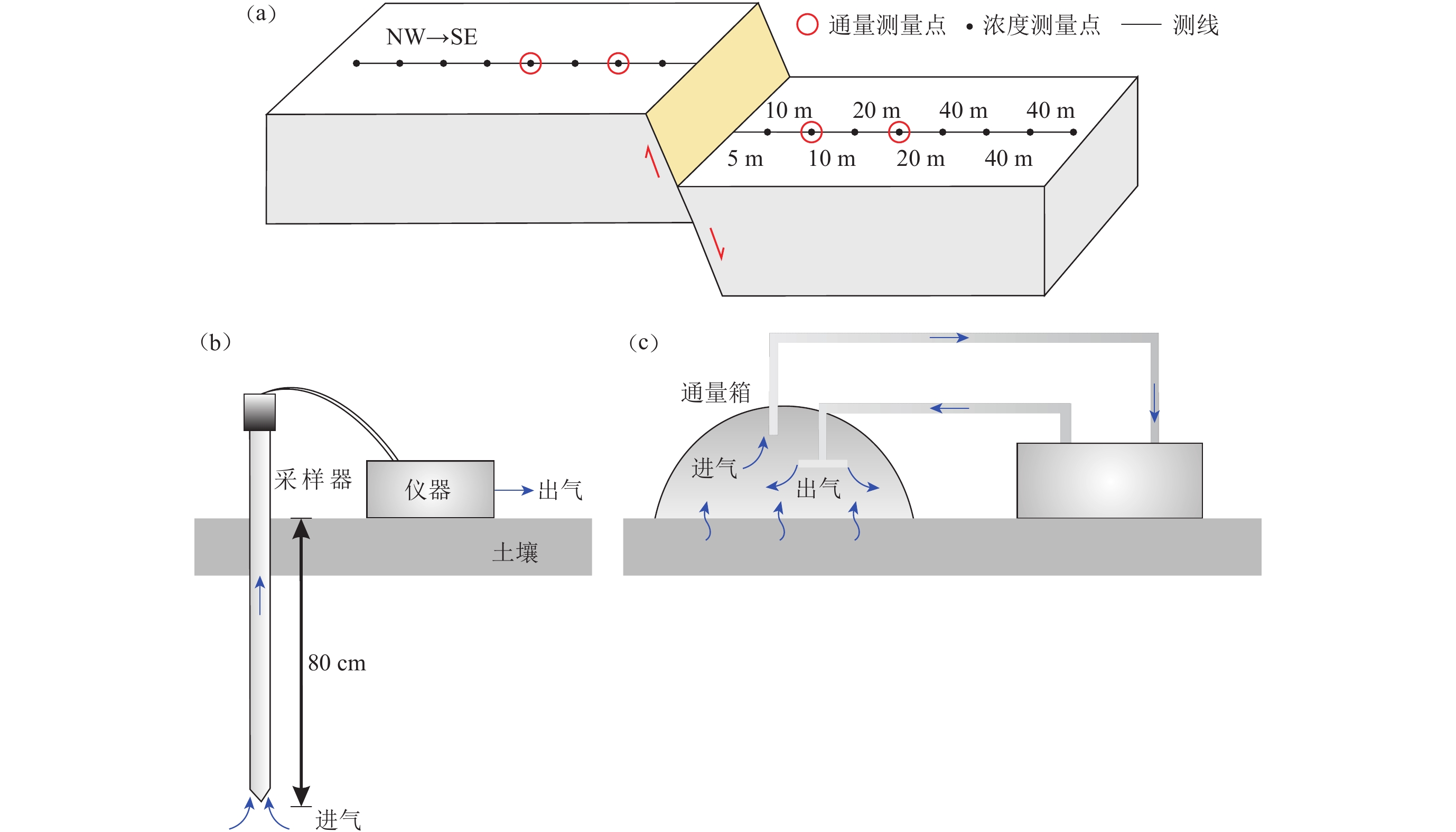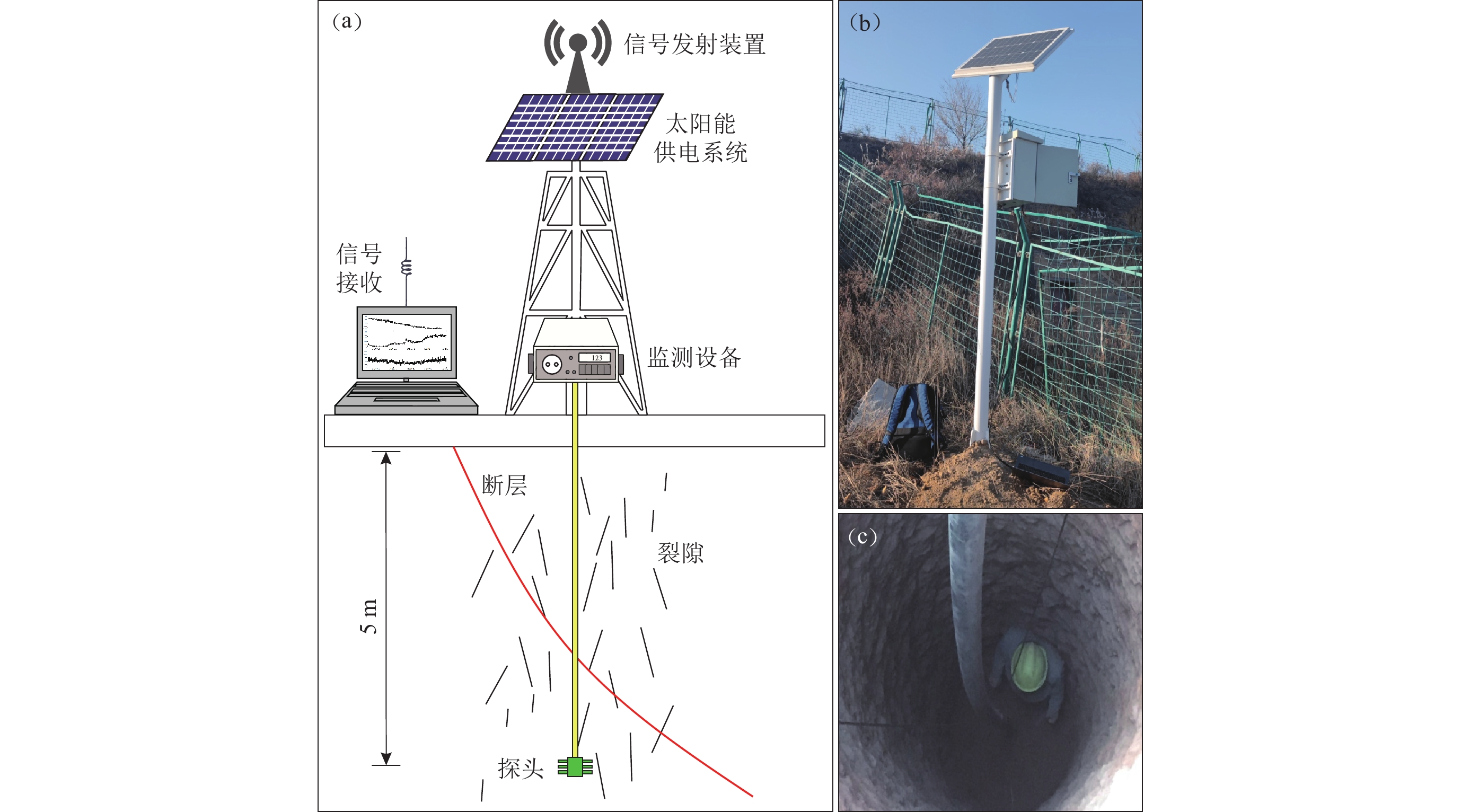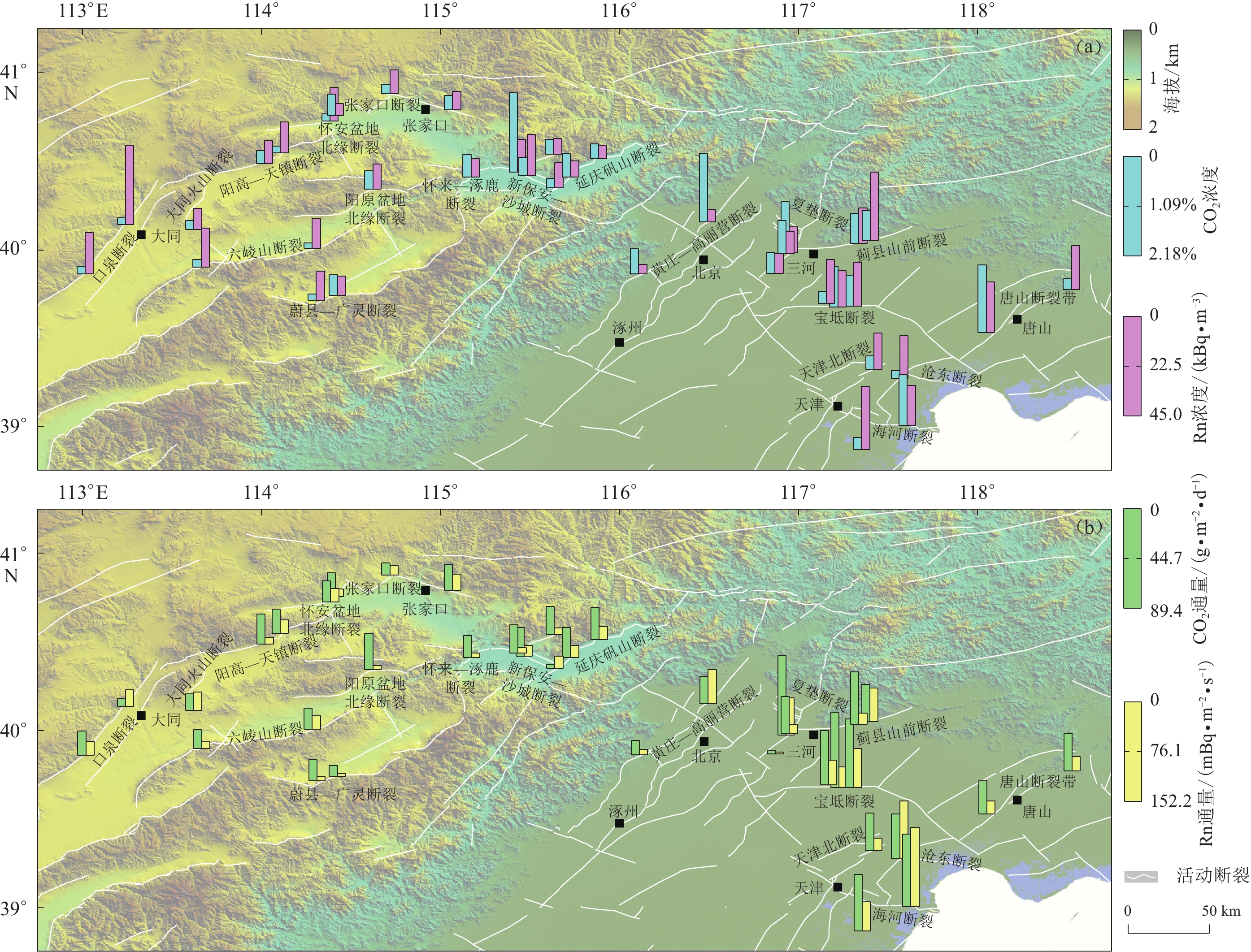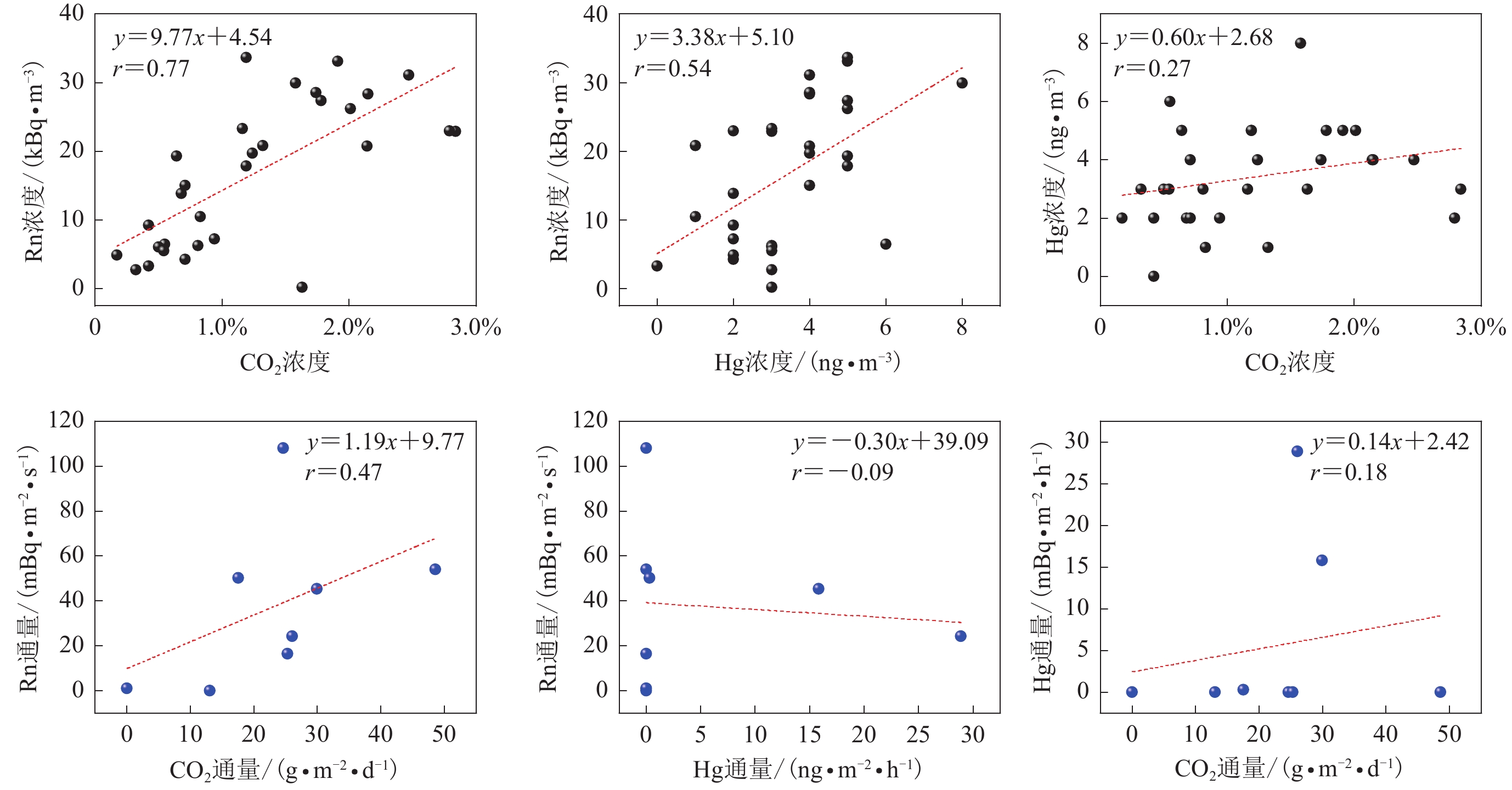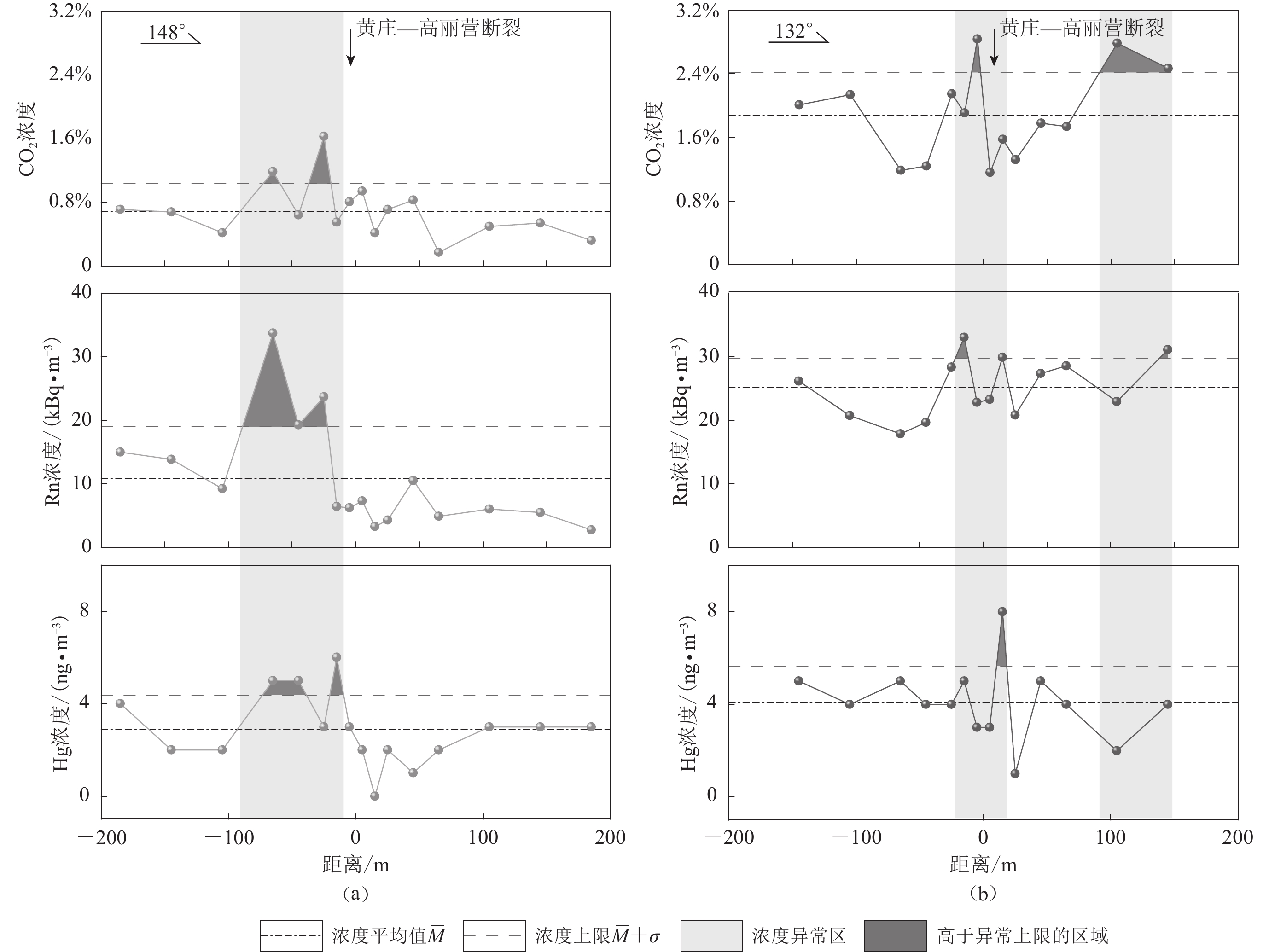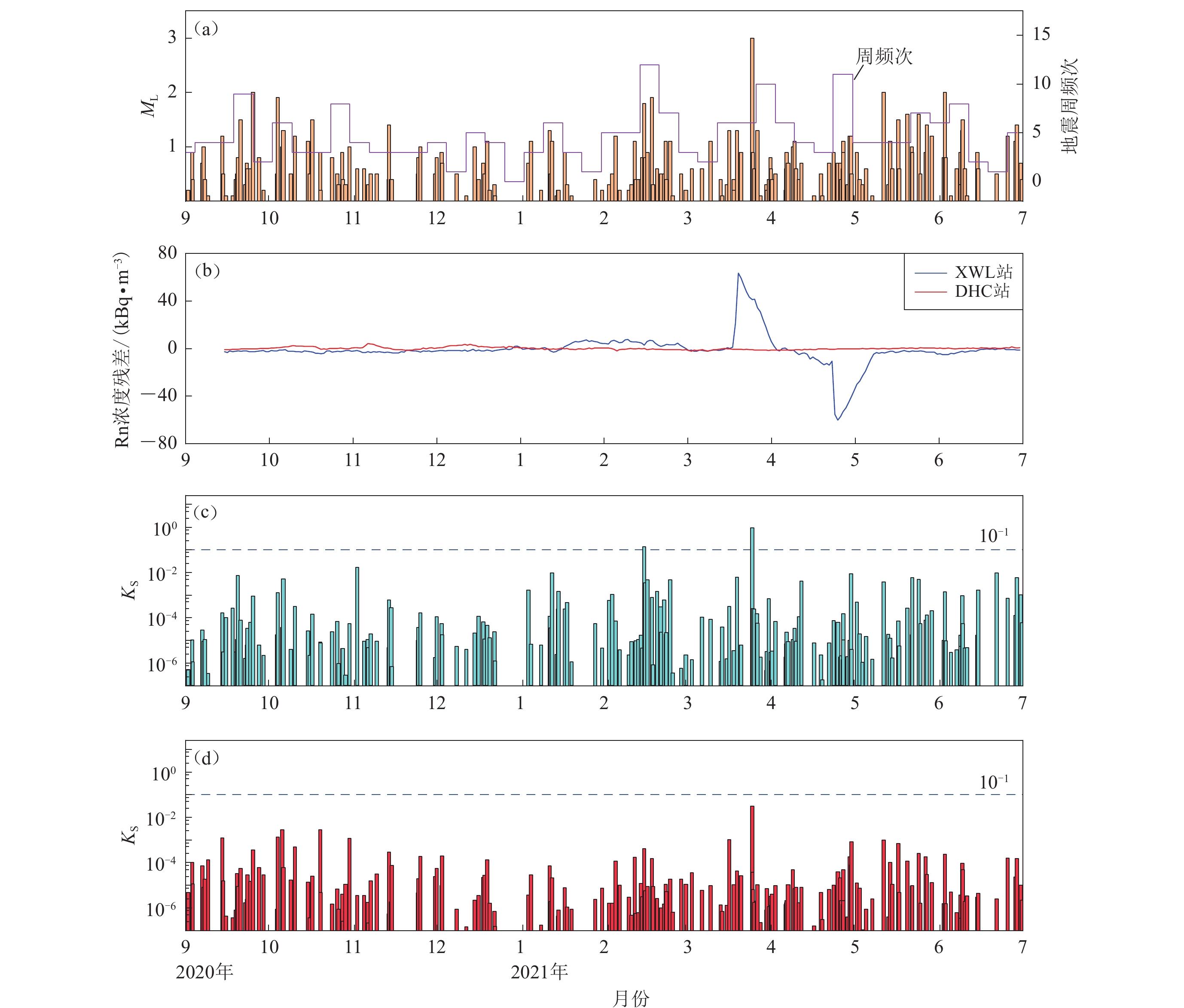Geochemical characteristics of soil gases on the Huangzhuang-Gaoliying fault in Beijing and their indications for seismic activity
-
摘要: 通过对2017年5月土壤气CO2,Rn和Hg的野外流动测量以及2020年9月1日至2021年6月30日期间土壤气监测站Rn的连续监测,利用残差法和地震指数KS方法对黄庄—高丽营断裂南北段的活动差异和区域地震活动进行了分析。结果表明,与首都圈地区其它断裂相比,黄庄—高丽营断裂是首都圈地区活动性相对较强的活动断裂,断裂北段的土壤气体浓度和通量较南段更高,且北段上盘的CO2和Rn浓度明显高于下盘,指示断裂北段具有更强的活动性。对土壤气连续监测站数据进行分析,结果显示监测站的Rn浓度与气温、土壤温度和气压之间无明显相关性。2021年3月25日北京顺义ML3.0地震前6天,监测站记录到Rn浓度出现异常升高,增加了一倍,且震后异常持续了一个月。顺义ML3.0地震前后Rn浓度的异常变化表明监测站的土壤气Rn浓度对KS>0.1的地震有很好的响应。Abstract: Based on the field flow observation of soil gas (CO2, Rn and Hg) in May of 2017 and continuous monitoring of soil gas Rn from September 1, 2020 to June 30, 2021, the residual signal and seismic index KS are used to study the activity difference between the south and north segments of Huangzhuang-Gaoliying fault and their regional seismicity. The results indicate that this fault is a relatively active fault compared with other faults in the capital circle region of China. The concentrations and fluxes of the soil gases in the north segment of the fault are higher than those in the south segment. And the CO2 and Rn concentrations in the hanging wall of the northern segment are significantly higher than those in the footwall. These indicate that the northern segment of the fault has stronger activity. Analyses on the continuous monitoring station data of soil gas Rn show there is no significant correlation between Rn concentration and air temperature, soil temperature, and air pressure. The Rn concentration at the monitoring station, six days prior to the Shunyi ML3.0 earthquake on March 25, 2021, was recorded to significantly increase, which doubled and persisted for a month after the earthquake. The anomalous variations of Rn concentration before and after the Shunyi ML3.0 earthquake indicate that the soil gas Rn concentration at the monitoring station exhibits a strong response to earthquakes with KS>0.1.
-
Keywords:
- soil gas /
- geochemistry /
- seismicity monitoring /
- Huangzhuang-Gaoliying fault
-
-
图 1 研究区地质图(改自马丽芳,2002)及地震分布图
F1:黄庄—高丽营断裂;F2:南口—孙河断裂;F3:顺义—良乡断裂。黑色圆圈代表公元438年12月24日至2020年5月26日的地震事件,蓝色圆圈代表2020年9月1日至2021年6月30日的地震事件(国家地震科学数字中心,2021a,b);地裂缝位置引自刘明坤等(2014)、张磊等(2017a,b)和赵帅等(2018);断裂数据引自邓起东等(2002)
Figure 1. Schematic geological map (modified from Ma,2002) and earthquakes in this study
F1:Huangzhuang-Gaoliying fault;F2:Nankou-Sunhe fault;F3:Shunyi-Liangxiang fault. Black circles stand for the earthquakes from December 24,AD 438 to May 26,2020,and blue circles for those from September 1,2020 to June 30,2021 (National Earthquake Data Center,2021a,b). The locations of ground fissures are cited from Liu et al (2014),Zhang et al (2017a,b) and Zhao et al (2018). Fault data are cited from Deng et al (2003)
图 4 首都圈地区主要活动断裂带土壤气体CO2和Rn的浓度(a)和通量(b)的平均值对比图
首都圈其它剖面数据引自王喜龙等(2017);断裂数据引自邓起东等(2002);DEM数据来自Bigemap软件
Figure 4. Comparison of the mean values of the soil gas (CO2 and Rn) concentrations (a) and fluxes (b) in the fault zones in the capital area
The data of other profiles in the capital circle region of China are cited from Wang et al (2017)。 Fault data are taken from Deng et al (2003),and DEM data are from Bigemap software
图 7 土壤气连续监测站的Rn浓度小时值、日均值变化和研究区内的地震事件(a)以及土壤温度、气温(b)、气压(c)和日降雨量(d)
Figure 7. Hourly variation and daily mean variation of Rn concentration at continuous monitoring stations of soil gas and earthquake events in the study area (a),as well as soil temperature,atmospheric temperature (b),atmospheric pressure (c) and daily rainfall (d)
表 1 黄庄—高丽营断裂土壤气体浓度
Table 1 The concentration of soil gases in the Huangzhuang-Gaoliying fault
点位 CO2浓度 Rn浓度/(kBq·m−3) Hg浓度/(ng·m−3) 点位 CO2浓度 Rn浓度/(kBq·m−3) Hg浓度/(ng·m−3) DHC-1 0.71% 14.99 4 XWL-1 2.01% 26.21 5 DHC-2 0.68% 13.85 2 XWL-2 2.14% 20.77 4 DHC-3 0.42% 9.22 2 XWL-3 1.19% 17.88 5 DHC-4 1.19% 33.68 5 XWL-4 1.24% 19.69 4 DHC-5 0.64% 19.29 5 XWL-5 2.15% 28.37 4 DHC-6 1.63% 23.66 3 XWL-6 1.91% 33.07 5 DHC-7 0.55% 6.45 6 XWL-7 2.84% 22.86 3 DHC-8 0.81% 6.25 3 XWL-8 1.16% 23.32 3 DHC-9 0.94% 7.26 2 XWL-9 1.58% 29.92 8 DHC-10 0.42% 3.28 0 XWL-10 1.32% 20.84 1 DHC-11 0.71% 4.28 2 XWL-11 1.78% 27.36 5 DHC-12 0.83% 10.49 1 XWL-12 1.74% 28.57 4 DHC-13 0.17% 4.91 2 XWL-13 2.79% 22.99 2 DHC-14 0.50% 6.03 3 XWL-14 2.47% 31.12 4 DHC-15 0.54% 5.51 3 平均值 1.88% 25.21 4 DHC-16 0.32% 2.76 3 平均值 0.69% 10.74 3 表 2 黄庄—高丽营断裂土壤气体通量
Table 2 The flux of soil gases in the Huangzhuang-Gaoliying fault
点位 CO2通量
/(g·m−2·d−1)Rn通量
/(mBq·m−2·s−1)Hg通量
/(ng·m−2·h−1)点位 CO2通量
/(g·m−2·d−1)Rn通量
/(mBq·m−2·s−1)Hg通量
/(ng·m−2·h−1)DHC-1 26.03 24.25 28.89 XWL-1 48.56 54.01 0 DHC-2 25.29 16.46 0 XWL-2 29.95 45.32 15.81 DHC-3 13.05 0 0 XWL-3 17.55 50.20 0.27 DHC-4 0 1.01 0 XWL-4 24.59 107.90 0 平均值 16.09 10.43 7.22 平均值 30.16 64.36 4.02 表 3 DHC和XWL剖面土壤样品中的TC,Hg,U和Ra的含量
Table 3 The content of TC,Hg,U and Ra in the soil samples from the DHC and XWL profiles
剖面 TC含量 Hg含量
/(ng·g−1)U含量
/ (Bq·kg−1)Ra含量
/ (Bq·kg−1)DHC 2.2% 91.0 25.2 20.0 XWL 0.4% 53.2 24.0 25.6 注:样品由核工业北京地质研究院分析测试中心进行检测 -
陈志,杜建国,周晓成,崔月菊,刘雷,李营,张文来,高小其,许秋龙,王海涛. 2014. 2012年6月30日新源MS6.6地震前后北天山泥火山及温泉的水化学变化[J]. 地震,34(3):97–107. doi: 10.3969/j.issn.1000-3274.2014.03.009 Chen Z,Du J G,Zhou X C,Cui Y J,Liu L,Li Y,Zhang W L,Gao X Q,Xu Q L,Wang H T. 2014. Hydrogeochemical changes of mud volcanoes and springs in North Tianshan related to the June 30,2012 Xinyuan MS6.6 earthquake[J]. Earthquake,34(3):97–107 (in Chinese).
邓起东,张培震,冉勇康,杨晓平,闵伟,楚全芝. 2002. 中国活动构造基本特征[J]. 中国科学:地球科学,32(12):1020–1030. Deng Q D,Zhang P Z,Ran Y K,Yang X P,Min W,Chu Q Z. 2003. Basic characteristics of active tectonics of China[J]. Science in China:Series D,46(4):356–372.
冯利斌. 2011. 北京未来科技城地裂缝成因机理及其防治对策研究[D]. 西安: 长安大学: 1–80. Feng L B. 2011. The Study on Formation Mechanism and Prevention Countermeasures of Ground Fissures in the Future Science and Technology City of Beijing[D]. Xi’an: Chang’an University: 1–80 (in Chinese).
国家地震科学数字中心. 2021a. 中国历史地震目录[EB/OL]. [2021-07-01]. https://data.earthquake.cn/datashare/report.shtml?PAGEID=earthquake_lsdz. National Earthquake Data Center. 2021a. Catalogue of Chinese historical earthquakes[EB/OL]. [2021-07-01]. https://data.earthquake.cn/datashare/report.shtml?PAGEID=earthquake_lsdz (in Chinese).
国家地震科学数字中心. 2021b. 中国台网正式地震目录[EB/OL]. [2021-07-01]. https://data.earthquake.cn/datashare/report.shtml?PAGEID=earthquake_zhengshi. National Earthquake Data Center. 2021b. Formal earthquakes catalogue of Chinese Seismic Networks[EB/OL]. [2021-07-01]. https://data.earthquake.cn/datashare/report.shtml?PAGEID=earthquake_zhengshi (in Chinese).
郭萌,王荣,王海刚,姜媛,刘明坤,田芳. 2013. 北京土沟—高丽营地裂缝成因分析[J]. 城市地质,8(2):5–8. doi: 10.3969/j.issn.1007-1903.2013.02.002 Guo M,Wang R,Wang H G,Jiang Y,Liu M K,Tian F. 2013. Discussion on the origin of Tugou-Gaoliying ground fissure[J]. Urban Geology,8(2):5–8 (in Chinese).
郭正府,郑国东,孙玉涛,张茂亮,张丽红,成智慧. 2017. 中国大陆地质源温室气体释放[J]. 矿物岩石地球化学通报,36(2):204–212. doi: 10.3969/j.issn.1007-2802.2017.02.003 Guo Z F, Zheng G D, Sun Y T, Zhang M L, Zhang L H, Cheng Z H. 2017. Greenhouse gases emitted from geological sources in China[J]. Bulletin of Mineralogy, Petrology and Geochemistry, 36(2): 204–212 (in Chinese).
焦青,邱泽华,范国胜. 2005. 北京地区八宝山—黄庄—高丽营断裂的活动与地震[J]. 大地测量与地球动力学,25(4):50–54. doi: 10.3969/j.issn.1671-5942.2005.04.011 Jiao Q,Qiu Z H,Fan G S. 2005. Analysis on recent tectonic activity and seismicity of Babaoshan-Huangzhuang-Gaoliying fault in Beijing region[J]. Journal of Geodesy and Geodynamics,25(4):50–54 (in Chinese).
李静,陈志,陆丽娜,周晓成,李营. 2018. 夏垫活动断裂CO2、Rn、Hg脱气对环境的影响[J]. 矿物岩石地球化学通报,37(4):629–638. Li J, Chen Z, Lu L N, Zhou X C, Li Y. 2018. Degassing of CO2, Rn and Hg from the Xiadian active fault and their environmental significance[J]. Bulletin of Mineralogy, Petrology and Geochemistry, 37(4): 629–638 (in Chinese).
李营,杜建国,王富宽,周晓成,盘晓东,魏汝庆. 2009. 延怀盆地土壤气体地球化学特征[J]. 地震学报,31(1):82–91. doi: 10.3321/j.issn:0253-3782.2009.01.009 Li Y,Du J G,Wang F K,Zhou X C,Pan X D,Wei R Q. 2009. Geochemical characteristics of soil gas in Yanqing-Huailai basin,North China[J]. Acta Seismologica Sinica,31(1):82–91 (in Chinese).
刘明坤,贾三满,陈柘舟,郭高轩. 2014. 北京平原区高丽营地裂缝带活动性及灾害特征研究[J]. 上海国土资源,35(4):53–57. doi: 10.3969/j.issn.2095-1329.2014.04.012 Liu M K,Jia S M,Chen Z Z,Guo G X. 2014. Study of the activity and impact of the Gaoliying ground fissure on the Beijing plain[J]. Shanghai Land and Resources,35(4):53–57 (in Chinese).
刘永梅,王华林,王纪强,周晓成,孙玉涛,陈志. 2016. 郯庐断裂带山东段土壤气体地球化学特征[J]. 地震地磁观测与研究,37(1):63–69. Liu Y M,Wang H L,Wang J Q,Zhou X C,Sun Y T,Chen Z. 2016. Geochemical characteristics of soil gas (Rn,CO2 and Hg) in the Shandong section of Tanlu fault zone[J]. Seismological and Geomagnetic Observation and Research,37(1):63–69 (in Chinese).
刘兆飞,李营,陈志,崔月菊,路畅,杨江,赵元鑫. 2019. 吉兰泰断陷盆地周缘断裂带气体释放及其对断层活动性的指示意义[J]. 地震学报,41(5):613–632. doi: 10.11939/jass.20190025 Liu Z F,Li Y,Chen Z,Cui Y J,Lu C,Yang J,Zhao Y X. 2019. Gas emission from active fault zones around the Jilantai faulted depression basin and its implications for fault activities[J]. Acta Seismologica Sinica,41(5):613–632 (in Chinese).
刘兆飞. 2020. 鄂尔多斯西缘断裂带土壤气体地球化学特征[D]. 北京: 中国地震局地震预测研究所: 1–76. Liu Z F. 2020. Soil Gas Geochemistry Characteristics in the Western Margin of the Ordos Block[D]. Beijing: Institute of Earthquake Forecasting, China Earthquake Administration: 1–76 (in Chinese).
马丽芳. 2002. 中国地质图集[M]. 北京: 地质出版社: 1–348. Ma L F. 2002. Geological Atlas of China[M]. Beijing: Geology Publishing House: 1–348 (in Chinese).
苏鹤军,张慧,李晨桦,伍剑波,周慧玲. 2013. 西秦岭北缘断裂带断层气浓度空间分布特征与强震危险性分析[J]. 地震工程学报,35(3):671–676. doi: 10.3969/j.issn.1000-0844.2013.03.0671 Su H J,Zhang H,Li C H,Wu J B,Zhou H L. 2013. Geochemical features of fault gas on northern margin fault of Xiqinling and its seismic hazard analysis[J]. China Earthquake Engineering Journal,35(3):671–676 (in Chinese).
陶明信,徐永昌,史宝光,蒋忠惕,沈平,李晓斌,孙明良. 2005. 中国不同类型断裂带的地幔脱气与深部地质构造特征[J]. 中国科学:地球科学,35(5):441–451. Tao M X, Xu Y C, Shi B G, Jiang Z T, Shen P, Li X B, Sun M L. 2005. Characteristics of mantle degassing and deep-seated geological structures in different typical fault zones of China[J]. Science in China: Series D, 48(7): 1074-1088.
王江,李营,陈志. 2017. 口泉断裂断层气地球化学变化特征及断层活动性[J]. 地震,37(1):39–51. doi: 10.3969/j.issn.1000-3274.2017.01.005 Wang J,Li Y,Chen Z. 2017. Gas geochemistry and activity of the Kouquan fault in Shanxi Province[J]. Earthquake,37(1):39–51 (in Chinese).
汪良谋,徐杰,黄秀铭,方仲景,张裕明,王辉. 1990. 北京拗陷构造活动性分析[J]. 中国地震,6(2):27–38. Wang L M,Xu J,Huang X M,Fang Z J,Zhang Y M,Wang H. 1990. An analysis on the tectonic activities in Beijing down-warped basin[J]. Earthquake Research in China,6(2):27–38 (in Chinese).
王喜龙,李营,杜建国,陈志,周晓成,李新艳,崔月菊,王海燕,张志宏. 2017. 首都圈地区土壤气Rn,Hg,CO2地球化学特征及其成因[J]. 地震学报,39(1):85–101. doi: 10.11939/jass.2017.01.008 Wang X L,Li Y,Du J G,Chen Z,Zhou X C,Li X Y,Cui Y J,Wang H Y,Zhang Z H. 2017. Geochemical characteristics of soil gases Rn,Hg and CO2 and their genesis in the capital area of China[J]. Acta Seismologica Sinica,39(1):85–101 (in Chinese).
王云,赵慈平,冉华,陈坤华. 2015. 地壳流体CO2的释放与地震关系:回顾与展望[J]. 地震研究,38(1):119–130. doi: 10.3969/j.issn.1000-0666.2015.01.016 Wang Y,Zhao C P,Ran H,Chen K H. 2015. The relationship between the release of crustal fluid CO2 and earthquake:Retrospect and prospect[J]. Journal of Seismological Research,38(1):119–130 (in Chinese).
吴清,高孟潭. 2018. 北京地区与雄安新区地震危险性相关性初探[J]. 地震地质,40(4):935–943. doi: 10.3969/j.issn.0253-4967.2018.04.015 Wu Q,Gao M T. 2018. A preliminary study on the correlativity of seismic hazard between Beijing area and Xiong’an new area[J]. Seismology and Geology,40(4):935–943 (in Chinese).
徐杰,汪良谋,方仲景,张裕明,王辉,黄秀铭,杨主恩,计凤桔. 1992. 北京八宝山断裂和黄庄—高丽营断裂构造活动性的初步分析[J]. 华北地震科学,10(3):1–11. Xu J,Wang L M,Fang Z J,Zhang Y M,Wang H,Huang X M,Yang Z E,Ji F J. 1992. Preliminary analysis of the tectonic activities of Babaoshan and Huangzhuang-Gaoliying faults in Beijing area[J]. North China Earthquake Sciences,10(3):1–11 (in Chinese).
徐平. 2006. 北京市地震监测志[M]. 北京: 地震出版社: 1–335. Xu P. 2006. Earthquake Monitoring Records in Beijing[M]. Beijing: Seismological Press: 1–335 (in Chinese).
徐锡伟, 吴卫民, 张先康, 马胜利, 马文涛, 于贵华, 顾梦林, 江娃利. 2002. 首都圈地区地壳最新构造变动与地震[M]. 北京: 科学出版社: 1–376. Xu X W, Wu W M, Zhang X K, Ma S L, Ma W T, Yu G H, Gu M L, Jiang W L. 2002. Latest Crustal Tectonic Change and Earthquakes in the Capital Area of China[M]. Beijing: Science Press: 1–376 (in Chinese).
杨景春,林伟凡,蒋铭,李格平. 1981. 北京八宝山断裂带近期构造活动及其和地震的关系[J]. 地震学报,3(4):390–398. Yang J C,Lin W F,Jiang M,Li G P. 1981. Recent tectonic movement of the Babaoshan fault near Beijing and its relation to earthquake occurrences[J]. Acta Seismologica Sinica,3(4):390–398 (in Chinese).
张慧,张新基,苏鹤军,刘旭宙. 2010. 兰州市活动断层土壤气汞、氡地球化学特征场地试验[J]. 西北地震学报,32(3):273–278. Zhang H,Zhang X J,Su H J,Liu X Z. 2010. Field test on the geochemical features of radon and mercury from soil gas on the active faults in Lanzhou[J]. Northwestern Seismological Journal,32(3):273–278 (in Chinese).
张磊,白凌燕,赵勇,张晓亮,杨天水,蔡向民,何付兵. 2017a. 北京南口—孙河断裂与黄庄—高丽营断裂交会区沉积速率差异对断裂活动性的响应[J]. 地震地质,39(5):1048–1065. Zhang L,Bai L Y,Zhao Y,Zhang X L,Yang T S,Cai X M,He F B. 2017a. The difference of deposition rate in the boreholes at the junction between Nankou-Sunhe fault and Huangzhuang-Gaoliying fault and its response to fault activity in the Beijing area[J]. Seismology and Geology,39(5):1048–1065 (in Chinese).
张磊,张晓亮,白凌燕,杨天水,蔡向民,梁亚南. 2017b. 北京地区黄庄—高丽营断裂北段活动性研究与灾害效应分析[J]. 地质力学学报,23(4):548–557. Zhang L,Zhang X L,Bai L Y,Yang T S,Cai X M,Liang Y N. 2017b. Activity study and disaster effect analysis of the north section of Huangzhuang-Gaoliying fault in Beijing[J]. Journal of Geomechanics,23(4):548–557 (in Chinese).
赵建明,李营,陈志,刘兆飞,赵荣琦,荣伟健. 2018. 蔚县—广灵断裂和口泉断裂气体排放和断裂活动性关系[J]. 地震地质,40(6):1402–1416. Zhao J M,Li Y,Chen Z,Liu Z F,Zhao R Q,Rong W J. 2018. Correlation between gas geochemical emission and fault activity of the Yuxian-Guangling and Kouquan faults[J]. Seismology and Geology,40(6):1402–1416 (in Chinese).
赵帅,孟勇琦,孙佳珺. 2018. 基于S波波速变化的北京市高丽营地区地裂缝发展趋势研究[J]. 地球科学前沿,8(7):1123–1130. Zhao S,Meng Y Q,Sun J J. 2018. Research in the trend of ground rupture development in Gaoliying of Beijing based on the variation of the S wave velocities[J]. Advances in Geosciences,8(7):1123–1130 (in Chinese). doi: 10.12677/AG.2018.87123
赵振燊,张慧,苏鹤军. 2011. 玛曲断裂带土壤气汞、氡地球化学特征[J]. 西北地震学报,33(4):376–379. Zhao Z S,Zhang H,Su H J. 2011. The geochemical features of mercury and radon on Maqu active fault[J]. Northwestern Seismological Journal,33(4):376–379 (in Chinese).
周晓成. 2011. 汶川MS8.0地震后川西地区的气体地球化学[D]. 合肥: 中国科学技术大学: 1–79. Zhou X C. 2011. Gas Geochemistry in Western Sichuan Related to 12 May 2008 Wenchuan MS8.0 Earthquake[D]. Hefei: University of Science and Technology of China: 1–79 (in Chinese).
周永恒,杨肖肖,丰成君,张鹏,孟静,谭成轩,邓亚虹,宋焱勋,王继明. 2021. 北京平原区黄庄—高丽营断裂(房山—涞水段)第四纪活动特征的浅层综合探测证据[J]. 地球学报,42(5):677–689. doi: 10.3975/cagsb.2020.012502 Zhou Y H,Yang X X,Feng C J,Zhang P,Meng J,Tan C X,Deng Y H,Song Y X,Wang J M. 2021. Evidence of shallow synthetic exploration of Quaternary activity characteristics along Fangshan-Laishui section of Huangzhuang-Gaoliying fault in Beijing plain[J]. Acta Geoscientica Sinica,42(5):677–689 (in Chinese).
Baixeras C,Erlandsson B,Font L,Jönsson G. 2001. Radon emanation from soil samples[J]. Radiat Meas,34(1/2/3/4/5/6):441–443.
Barberio M D,Gori F,Barbieri M,Billi A,Devoti R,Doglioni C,Petitta M,Riguzzi F,Rusi S. 2018. Diurnal and semidiurnal cyclicity of Radon (222Rn) in groundwater,Giardino Spring,central Apennines,Italy[J]. Water,10(9):1276. doi: 10.3390/w10091276
Barbosa S M,Zafrir H,Malik U,Piatibratova O. 2010. Multiyear to daily radon variability from continuous monitoring at the Amram tunnel,southern Israel[J]. Geophys J Int,182(2):829–842. doi: 10.1111/j.1365-246X.2010.04660.x
Biagi P F,Molchanov O,Piccolo R,Minafra A,Ermini A,Capozzi V,Khatkevich Y M,Gordeev E I. 2003. Co-postseismic hydrogeochemical anomalies in a volcanic environment[J]. Nat Hazards Earth Syst Sci,3(3/4):263–267. doi: 10.5194/nhess-3-263-2003
Biagi P F,Castellana L,Minafra A,Maggipinto G,Maggipinto T,Ermini A,Molchanov O,Khatkevich Y M,Gordeev E I. 2006. Groundwater chemical anomalies connected with the Kamchatka earthquake (M=7.1) on March 1992[J]. Nat Hazards Earth Syst Sci,6(5):853–859. doi: 10.5194/nhess-6-853-2006
Chen Z,Li Y,Liu Z F,Wang J,Zhou X C,Du J G. 2018. Radon emission from soil gases in the active fault zones in the Capital of China and its environmental effects[J]. Sci Rep,8(1):16772. doi: 10.1038/s41598-018-35262-1
Chen Z,Li Y,Liu Z F,Zheng G D,Xu W,Yan W,Yi L. 2019. CH4 and CO2 emissions from mud volcanoes on the southern margin of the Junggar basin,NW China:Origin,output,and relation to regional tectonics[J]. J Geophys Res:Solid Earth,124(5):5030–5044. doi: 10.1029/2018JB016822
Chiodini G,Frondini F,Kerrick D M,Rogie J,Parello F,Peruzzi L,Zanzari A R. 1999. Quantification of deep CO2 fluxes from Central Italy. Examples of carbon balance for regional aquifers and of soil diffuse degassing[J]. Chem Geol,159(1/2/3/4):205–222.
Crockett R G M,Gillmore G K,Phillips P S,Denman A R,Groves-Kirkby C J. 2006. Tidal synchronicity of built-environment radon levels in the UK[J]. Geophys Res Lett,33(5):L05308.
Fu C C,Walia V,Yang T F,Lee L C,Liu T K,Chen C H,Kumar A,Lin S J,Lai T H,Wen K L. 2017a. Preseismic anomalies in soil-gas radon associated with 2016 M6.6 Meinong earthquake,southern Taiwan[J]. Terr Atmos Ocean Sci,28(5):787–798. doi: 10.3319/TAO.2017.03.22.01
Fu C C,Yang T F,Tsai M C,Lee L C,Liu T K,Walia V,Chen C H,Chang W Y,Kumar A,Lai T H. 2017b. Exploring the relationship between soil degassing and seismic activity by continuous radon monitoring in the Longitudinal Valley of eastern Taiwan[J]. Chem Geol,469:163–175. doi: 10.1016/j.chemgeo.2016.12.042
Girault F,Schubnel A,Pili É. 2017. Transient radon signals driven by fluid pressure pulse,micro-crack closure,and failure during granite deformation experiments[J]. Earth Planet Sci Lett,474:409–418. doi: 10.1016/j.jpgl.2017.07.013
Han X,Li Y,Du J,Zhou X,Xie C,Zhang W. 2014. Rn and CO2 geochemistry of soil gas across the active fault zones in the capital area of China[J]. Nat Hazards Earth Syst Sci,14(10):2803–2815. doi: 10.5194/nhess-14-2803-2014
İnan S,Kop A,Çetin H,Kulak F,Pabuçcu Z,Seyis C,Ergintav S,Tan O,Saatçılar R,Bodur M N. 2012. Seasonal variations in soil radon emanation:Long-term continuous monitoring in light of seismicity[J]. Nat Hazards,62(2):575–591. doi: 10.1007/s11069-012-0096-6
Kitto M E. 2005. Interrelationship of indoor radon concentrations,soil-gas flux,and meteorological parameters[J]. J Radioanal Nucl Chem,264(2):381–385. doi: 10.1007/s10967-005-0725-6
Lehmann B E,Lehmann M,Neftel A,Tarakanov S V. 2000. Radon-222 monitoring of soil diffusivity[J]. Geophys Res Lett,27(23):3917–3920. doi: 10.1029/1999GL008469
Li Y,Du J G,Wang X,Zhou X C,Xie C,Cui Y J. 2013. Spatial variations of soil gas geochemistry in the Tangshan area of northern China[J]. Terr Atmos Ocean Sci,24(3):323–332. doi: 10.3319/TAO.2012.11.26.01(TT)
Martinelli G. 1991. Fluidodynamical and chemical features of radon 222 related to total gases: Implications for earthquake predictions[C]//Isotopic and Geochemical Precursors of Earthquakes and Volcanic Eruptions. Vienna: International Atomic Energy Agency: 48–62.
Miklyaev P S,Petrova T B,Marennyy A M,Shchitov D V,Sidyakin P A,Murzabekov M А,Lopatin M N. 2020. High seasonal variations of the radon exhalation from soil surface in the fault zones (Baikal and North Caucasus regions)[J]. J Environ Radioact,219:106271. doi: 10.1016/j.jenvrad.2020.106271
Molchanov O,Schekotov A,Fedorov E,Belyaev G,Gordeev E. 2003. Preseismic ULF electromagnetic effect from observation at Kamchatka[J]. Nat Hazards Earth Syst Sci,3(3/4):203–209. doi: 10.5194/nhess-3-203-2003
Moreno V,Bach J,Font L,Baixeras C,Zarroca M,Linares R,Roqué C. 2016. Soil radon dynamics in the Amer fault zone:An example of very high seasonal variations[J]. J Environ Radioact,151:293–303. doi: 10.1016/j.jenvrad.2015.10.018
Papp B,Deák F,Horváth Á,Kiss Á,Rajnai G,Szabó C. 2008. A new method for the determination of geophysical parameters by radon concentration measurements in bore-hole[J]. J Environ Radioact,99(11):1731–1735. doi: 10.1016/j.jenvrad.2008.05.005
Phong Thu H N,Van Thang N,Hao L C. 2020. The effects of some soil characteristics on radon emanation and diffusion[J]. J Environ Radioact,216:106189. doi: 10.1016/j.jenvrad.2020.106189
Richon P,Moreau L,Sabroux J C,Pili E,Salaün A. 2012. Evidence of both M2 and O1 Earth tide waves in radon-222 air concentration measured in a subglacial laboratory[J]. J Geophys Res:Solid Earth,117(B12):B12404.
Schekotov A Y,Molchanov O A,Hayakawa M,Fedorov E N,Chebrov V N,Sinitsin V I,Gordeev E E,Belyaev G G,Yagova N V. 2007. ULF/ELF magnetic field variations from atmosphere induced by seismicity[J]. Radio Sci,42(6):RS6S90.
Seminsky K Z,Demberel S,Tugarina M A,Ganzorig D,Bornyakov S A. 2013. First estimates of soil radon activity in the fault zones of central Mongolia[J]. Dokl Earth Sci,448(1):21–24. doi: 10.1134/S1028334X12110128
Seminsky K Z,Bobrov A A,Demberel S. 2014. Variations in radon activity in the crustal fault zones:Spatial characteristics[J]. Izv-Phys Solid Earth,50(6):795–813. doi: 10.1134/S1069351314060081
Shukla V,Chauhan V,Kumar N,Hazarika D. 2020. Assessment of Rn-222 continuous time series for the identification of anomalous changes during moderate earthquakes of the Garhwal Himalaya[J]. Appl Radiat Isot,166:109327. doi: 10.1016/j.apradiso.2020.109327
Wakita H,Nakamura Y,Kita I,Fujii N,Notsu K. 1980. Hydrogen release:New indicator of fault activity[J]. Science,210(4466):188–190. doi: 10.1126/science.210.4466.188
Winkler R,Ruckerbauer F,Bunzl K. 2001. Radon concentration in soil gas:A comparison of the variability resulting from different methods,spatial heterogeneity and seasonal fluctuations[J]. Sci Total Environ,272(1/2/3):273–282.
Yang Y,Li Y,Guan Z J,Chen Z,Zhang L,Lü C J,Sun F X. 2018. Correlations between the radon concentrations in soil gas and the activity of the Anninghe and the Zemuhe faults in Sichuan,southwestern of China[J]. Appl Geochem,89:23–33. doi: 10.1016/j.apgeochem.2017.11.006
Yuce G,Fu C C,D’Alessandro W,Gulbay A H,Lai C W,Bellomo S,Yang T F,Italiano F,Walia V. 2017. Geochemical characteristics of soil radon and carbon dioxide within the Dead Sea fault and Karasu fault in the Amik Basin (Hatay),Turkey[J]. Chem Geol,469:129–146. doi: 10.1016/j.chemgeo.2017.01.003
Zafrir H,Steinitz G,Malik U,Haquin G,Gazit-Yaari N. 2009. Response of Radon in a seismic calibration explosion,Israel[J]. Radiat Meas,44(2):193–198. doi: 10.1016/j.radmeas.2009.01.002
Zheng G D,Xu S,Liang S Y,Shi P L,Zhao J. 2013. Gas emission from the Qingzhu River after the 2008 Wenchuan earthquake,Southwest China[J]. Chem Geol,339:187–193. doi: 10.1016/j.chemgeo.2012.10.032
Zhou X C,Chen Z,Cui Y J. 2016. Environmental impact of CO2,Rn,Hg degassing from the rupture zones produced by Wenchuan MS8.0 earthquake in western Sichuan,China[J]. Environ Geochem Health,38(5):1067–1082. doi: 10.1007/s10653-015-9773-1




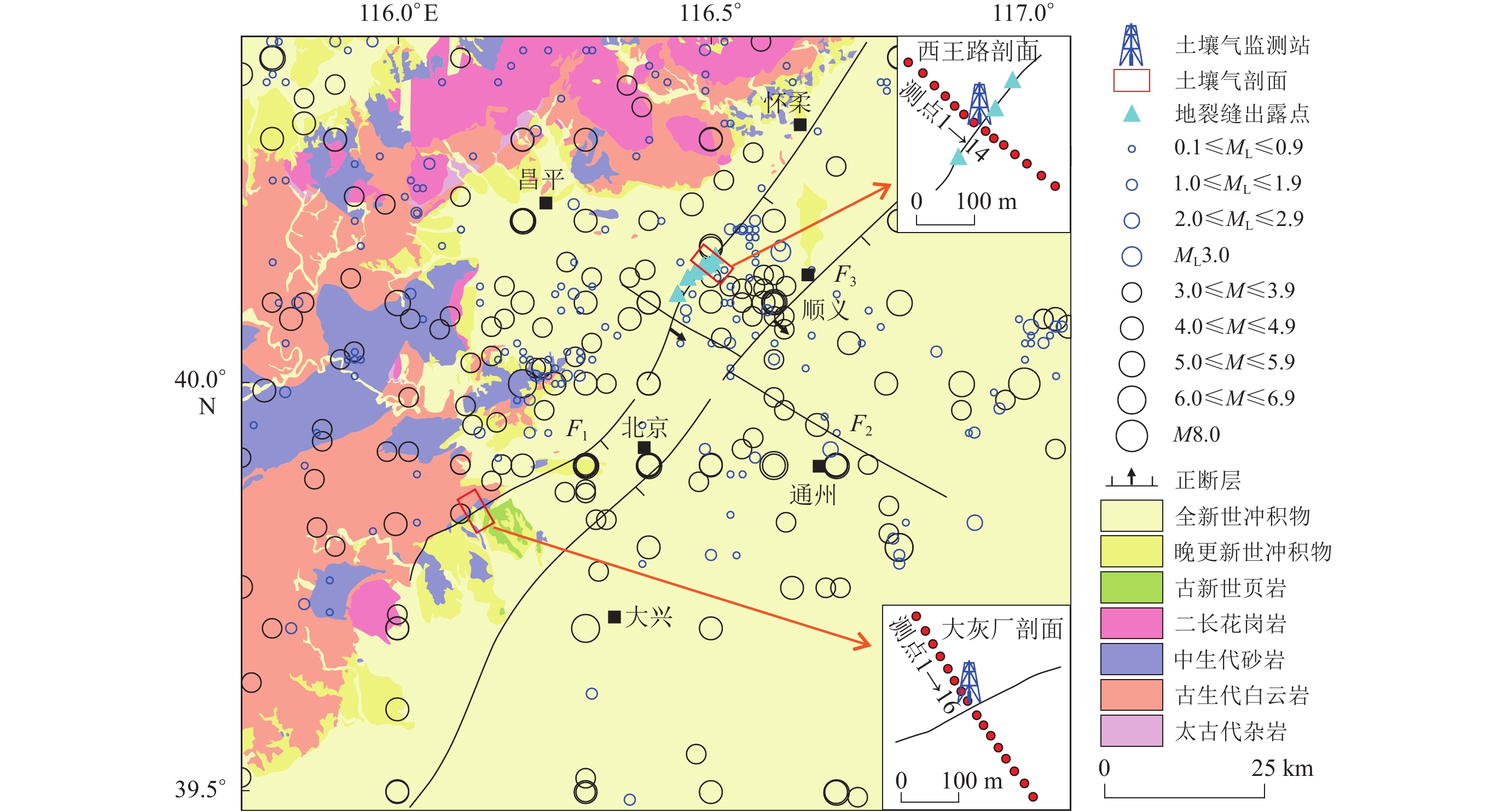
 下载:
下载:
